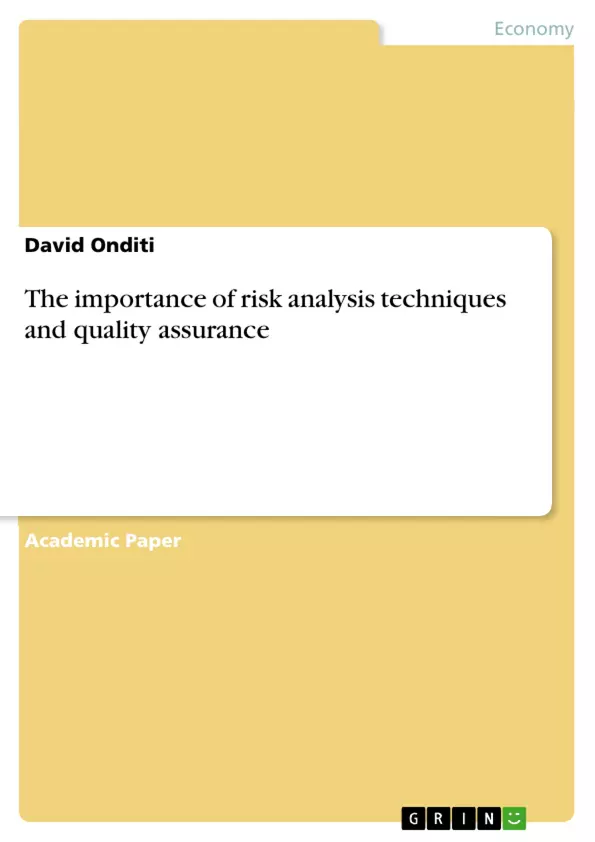The author gives an example of a quality assurance and control plan and a risk matrix, which includes the risks, probability and importance of the risks and the action plan as well as the person responsible for the risks.
There are a number of risk analysis techniques. Brainstorming is primarily used in the project planning stage to identify as well as postulate the various risk scenarios. It helps project teams to creatively think as a group by building on various ideas. SWOT analysis is another framework of risk analysis that can be applied in a project as a means of assessing the external and internal influence that can have an impact on the project. The influences can either be positive or negative. Root cause analysis (RCA) is a method applied in analysing the adverse and serious events through the identification of problems that increase the likelihood of errors without focusing on individuals’ mistakes.
Inhaltsverzeichnis (Table of Contents)
- Risk Assessment and Quality Plan
- Part Two: Risk Matrix
Zielsetzung und Themenschwerpunkte (Objectives and Key Themes)
The objective of this document is to outline a risk assessment and quality plan for a project, identifying potential risks and outlining mitigation strategies. The plan utilizes several risk analysis techniques to comprehensively address potential challenges.
- Risk Identification and Assessment
- Risk Mitigation Strategies
- Use of Brainstorming, SWOT Analysis, and Root Cause Analysis
- Legal and Ethical Considerations (Privacy)
- Risk Matrix Development
Zusammenfassung der Kapitel (Chapter Summaries)
Risk Assessment and Quality Plan: This section details the methodology for assessing and managing project risks. It introduces brainstorming, SWOT analysis, and root cause analysis (RCA) as key techniques. Brainstorming fosters creative problem-solving, SWOT analysis evaluates internal and external factors influencing the project (strengths, weaknesses, opportunities, and threats), and RCA focuses on identifying and eliminating latent (systemic) and active (human-interface) errors to prevent future harm. The text highlights the application of brainstorming and SWOT analysis throughout the project lifecycle, while RCA is primarily used post-implementation to address problems. Specific project strengths (strong staff buy-in) and weaknesses (time constraints, skilled staff shortages) are identified using the SWOT framework. Opportunities (existing Q-Matic installations, collaboration with Q-Matic Corp.) and threats (poor cleanup leading to safety concerns, potential vendor selection delays) are also analyzed. Several risks are identified, including late delivery, accidents, time constraints, software quality issues, inadequate design, scope creep, schedule optimism, contractor failure, technology readiness, and poor team dynamics. Finally, the chapter addresses legal and ethical concerns related to patient data privacy, emphasizing the need for robust data security measures and access controls.
Part Two: Risk Matrix: This section presents a risk matrix that categorizes identified risks by probability and importance. Each risk is assigned an action plan and a responsible party. Examples provided include risks related to poor team dynamics, contractor failure, overly optimistic schedules, scope creep, poor software quality, and inadequate design. The matrix indicates the status of each risk's mitigation plan (e.g., system in place, ongoing, completed).
Schlüsselwörter (Keywords)
Risk assessment, quality plan, brainstorming, SWOT analysis, root cause analysis (RCA), risk matrix, risk mitigation, project management, patient data privacy, legal and ethical considerations, team dynamics, contractor management, schedule management, software quality, risk probability, risk importance.
Frequently Asked Questions: Comprehensive Language Preview - Risk Assessment and Quality Plan
What is the purpose of this document?
This document outlines a risk assessment and quality plan for a project. It identifies potential risks and details mitigation strategies using various risk analysis techniques.
What risk assessment techniques are used?
The plan utilizes brainstorming, SWOT analysis (Strengths, Weaknesses, Opportunities, Threats), and Root Cause Analysis (RCA). Brainstorming encourages creative problem-solving. SWOT analysis evaluates internal and external factors. RCA identifies and eliminates errors to prevent future harm. The application of these techniques throughout the project lifecycle is explained.
How are risks categorized and managed?
A risk matrix categorizes identified risks by probability and importance. Each risk has an assigned action plan and responsible party. The matrix tracks the status of each risk's mitigation plan (e.g., system in place, ongoing, completed).
What specific risks are identified in the document?
Several risks are identified, including late delivery, accidents, time constraints, software quality issues, inadequate design, scope creep, schedule optimism, contractor failure, technology readiness, and poor team dynamics. The document also addresses risks related to poor team dynamics, contractor failure, overly optimistic schedules, scope creep, poor software quality, and inadequate design within the risk matrix.
What are the legal and ethical considerations discussed?
The document emphasizes legal and ethical concerns related to patient data privacy, highlighting the need for robust data security measures and access controls.
What is the scope of the Risk Assessment and Quality Plan chapter?
This section details the methodology for assessing and managing project risks. It explains the application of brainstorming, SWOT analysis, and RCA within the context of the project, including specific examples of project strengths and weaknesses, opportunities, and threats.
What is the scope of the Risk Matrix chapter?
This section presents the risk matrix, categorizing risks by probability and importance. Each risk includes an action plan and assigned responsibility, along with the status of its mitigation plan.
What are the key takeaways from the document?
The key takeaways involve a comprehensive approach to risk assessment and management using multiple techniques, a clear understanding of potential project risks and their mitigation strategies, and an emphasis on legal and ethical considerations, particularly regarding data privacy.
What are the keywords associated with this document?
Risk assessment, quality plan, brainstorming, SWOT analysis, root cause analysis (RCA), risk matrix, risk mitigation, project management, patient data privacy, legal and ethical considerations, team dynamics, contractor management, schedule management, software quality, risk probability, risk importance.
- Citation du texte
- David Onditi (Auteur), 2018, The importance of risk analysis techniques and quality assurance, Munich, GRIN Verlag, https://www.grin.com/document/492966



